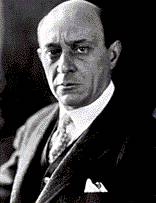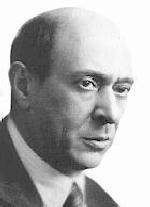Arnold Schönberg (1874-1951)
 (born
Vienna, 13 September 1874; died Los Angeles, 13 July 1951).
(born
Vienna, 13 September 1874; died Los Angeles, 13 July 1951).
Austro-Hungarian composer, an American citizen from 1941.
He began violin lessons when he was eight and almost immediately started
composing, though he had no formal training until he was in his late teens,
when Zemlinsky became his teacher and friend (in 1910 he married Zemlinsky's
sister). His first acknowledged works date from the turn of the century
and include the string sextet "Verklärte
Nacht" as well as some songs, all showing influences from Brahms,
Wagner
and Wolf. In 1901-3 he was in
Berlin as a cabaret musician and teacher, and there he wrote the
symphonic
poem "Pelleas und Melisande", pressing
the Straussian model towards denser thematic
argument and contrapuntal richness. He then returned to Vienna and began
taking private pupils, Berg and Webern
being among the first. He also moved rapidly forwards in his musical style.
The large orchestra of "Pelleas" and the "Gurrelieder"
(a huge symphonic cantata),
was replaced by an ensemble of 15 in "Chamber
Symphony no.1" (1907), but with an intensification
of harmonic strangeness,
formal complexity
and contrapuntal density: like the "String
Quartet no.1" (1905), the work is cast as a single movement
encompassing the characters of the traditional four and using every effort
to join unconventional ideas (a sequence of
4ths in the Chamber Symphony, for instance) into a conventional discourse.
When atonality arrived, therefore, as it did in 1908, it came as the inevitable
outcome of a doomed attempt to accommodate ever more disruptive material.
However, Schönberg found it possible a quarter-century later to return
to something like his tonal style in such works as the "Suite
in G" for strings, the completion of the "Chamber
Symphony no.2" and the "Theme and Variations"
for band.
That, however, was not possible immediately. The sense of key was left
behind as Schönberg set poems by Stefan George in the last two movements
of "String Quartet no.2 (1908)"
and in the song cycle "Das Buch der hängenden
Gärten" (often referred to as the first piece written in
the new style), and for the next few years he lived in the new, rarefied
musical air. With tonality had gone thematicism and rhythmic constraint;
works tended to be short statements of a single extreme musical state,
justifying the term 'expressionist'
("Five Orchestral Pieces";
"Three Piano Pieces").
The larger pieces of this period have some appropriate dramatic content:
the rage and despair of a woman seaching for her lover ("Erwartung"),
the bizarre stories, melancholia and jokes of a distintegrating personality
-- ("Pierrot lunaire" (1912), for reciter
in
Sprechgesang with mixed
quintet), or the progress of the soul towards union with God ("Die
Jakobsleiter" -- unfinished oratorio). "Die
glückliche Hand" (1913), the one-act "drama with music,"
is from this same period as well. Historically, "Pierrot" is of particular
interest as it gives the first indication of a change in Schönberg's
thinking that was to become more evident in later years. Several
of the songs feature
elaborate contrapuntal structures
of a relatively strict kind, marking a turn from the freer approach of
the preceding works.

Gradually Schönberg came to find the means for writing longer
instrumental structures, in the 12-tone
serial method, and in the 1920s he retumed to standard forms and genres,
notably in the "Suite for piano" (1924)
-- his first completely 12-tone work, "String
Quartet no.3" (1927), "Variations for
Orchestra"(1928) -- in which we see the
technique of combinatoriality in an extended setting, and
several choral pieces. He also founded the Society
for Private Musical Performances (1919-21), involving his pupils
in the presentation of new music under favorable conditions. In 1923 his
wife died (he remarried the next year), and in 1925 he moved to Berlin
to take a master class at the Prussian Academy of Arts. While there he
wrote much of his unfinished opera "Moses und
Aron" which is concerned with the impossibility of communicating
truth without some distortion in the telling: it was a vehement confrontation
with despair on the part of a composer who insisted on the highest standards
of artistic honesty.
In 1933 he was obliged as a Jew to leave Berlin:
he went to Paris, and formally returned to the faith which he had deserted
for Lutheranism in 1898. Later the same year he arrived in the USA, and
he settled in Los Angeles in 1934. It was there that
he returned to tonal composition, while developing serialism to
make possible the more complex structures of the "Violin
Concerto" and the "String Quartet no.4".
In 1936 he began teaching at UCLA and his
output dwindled. After a heart attack in 1945, however,
he
gave up teaching and made some return to expressionism
("A Survivor from Warsaw", "String
Trio"), as well as writing religious choruses.
(see also article: The
Second Viennese School)

 (born
Vienna, 13 September 1874; died Los Angeles, 13 July 1951).
(born
Vienna, 13 September 1874; died Los Angeles, 13 July 1951).